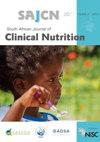埃塞俄比亚两个干旱易发地区0-60个月儿童的营养状况
IF 0.6
Q4 NUTRITION & DIETETICS
引用次数: 8
摘要
目的:开展了一项研究,以评估埃塞俄比亚两个干旱易发地区五岁以下儿童营养不良的患病率及其相关因素。研究设计和设置:通过横断面、混合方法,使用多阶段随机抽样方法分析数据。研究对象和结果测量:从350个家庭收集社会经济因素、人口统计特征和人体测量数据。使用世界卫生组织Anthro软件计算304名0至60个月儿童的身高(HAZ)、身高(WHZ)和年龄(WAZ)z评分。HAZ、WHZ和WAZ的z评分低于−2标准差(SD)的儿童分别被归类为发育迟缓、消瘦和体重不足。使用描述性统计、t检验、相关性和回归分析来评估自变量与发育迟缓和体重不足之间的关系。结果:发育迟缓、消瘦和体重不足的患病率分别为49.4%、13.7%和37.1%。在测试的自变量中,农业生态学与发育迟缓显著相关(p = 0.012)和体重不足(p < 0.001),而牲畜饲养与发育迟缓显著相关(p = 0.008)和体重不足(p = 0.012)。获得灌溉也与发育迟缓显著相关(p = 0.028)和体重不足(p = 0.016)。然而,发育迟缓、消瘦和体重不足的患病率与家庭规模、土地保有量或患病频率没有显著关联。结论:研究区域内营养不良的患病率高于埃塞俄比亚的全国平均水平。低地地区营养不良率最高;因此,包括增加牲畜保有量和获得灌溉的干预措施应包括农业生态因素,以减少儿童营养不良。本文章由计算机程序翻译,如有差异,请以英文原文为准。
Nutritional status of children aged 0–60 months in two drought-prone areas of Ethiopia
Objectives: A study was undertaken to assess the prevalence of undernutrition and associated factors among children under five in two drought-prone areas in Ethiopia. Study design and setting: Through a cross-sectional, mixed-methods approach, data were analysed using multistage random sampling methods. Study subjects and outcome measures: Data were collected on socioeconomic factors, demographic characteristics and anthropometric measurements from 350 households. Height-for-age (HAZ), weight-for-height (WHZ) and weight-for-age (WAZ) z-scores of 304 children, aged 0–60 months, were calculated using the WHO Anthro software. Children with z-scores of less than −2 standard deviations (SDs) for HAZ, WHZ and WAZ were classified as stunted, wasted and underweight respectively. Descriptive statistics, t-tests, correlation and regression analyses were used to assess the relationships between independent variables and stunting and underweight. Results: Prevalence of stunting, wasting and underweight were 49.4%, 13.7% and 37.1% respectively. Among independent variables tested, agroecology was significantly associated with stunting (p = 0.012) and underweight (p < 0.001), while livestock holding was significantly correlated with stunting (p = 0.008) and underweight (p = 0.012). Access to irrigation was also significantly associated with stunting (p = 0.028) and underweight (p = 0.016). However, the prevalence of stunting, wasting and underweight was not significantly associated with household size, landholdings or frequency of sickness. Conclusions: The prevalence of undernutrition within the study areas was higher than the national average for Ethiopia. Lowland areas exhibited the highest rates of undernutrition; consequently, interventions that include the enhancement of livestock holdings and access to irrigation should include agroecological factors in an effort to reduce childhood undernutrition.
求助全文
通过发布文献求助,成功后即可免费获取论文全文。
去求助
来源期刊

South African Journal of Clinical Nutrition
NUTRITION & DIETETICS-
CiteScore
2.50
自引率
9.10%
发文量
21
期刊介绍:
1.The Journal accepts articles from all basic and applied areas of dietetics and human nutrition, including clinical nutrition, community nutrition, food science, food policy, food service management, nutrition policy and public health nutrition. 2.The Journal has a broad interpretation of the field of nutrition and recognizes that there are many factors that determine nutritional status and that need to be the subject of scientific investigation and reported in the Journal. 3.The Journal seeks to serve a broad readership and to provide information that will be useful to the scientific community, the academic community, government and non-government stakeholders in the nutrition field, policy makers and industry.
 求助内容:
求助内容: 应助结果提醒方式:
应助结果提醒方式:


